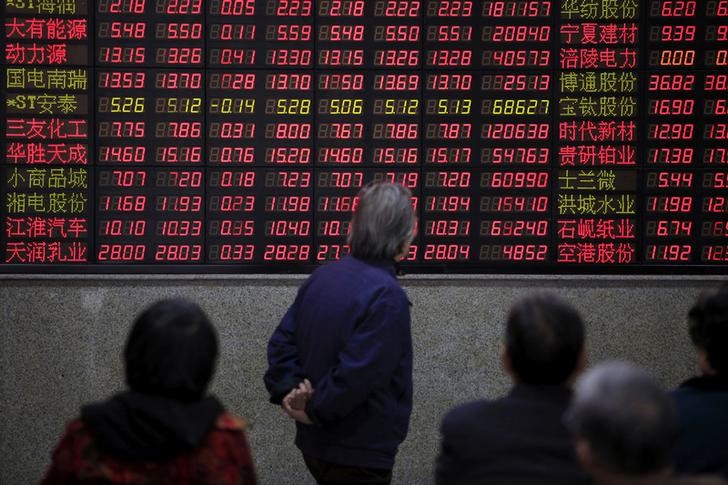
By Marc Jones
LONDON (Reuters) – A slump in oil prices to the lowest in almost six months rattled markets on Friday, prompting a rally in safe-haven bonds, the yen and gold and taking the shine off a record-breaking week for world stocks.
Bourses flinched in both Asia and Europe and Wall Street also looked set for a subdued start as investors, who had been expecting to spend the day mostly looking ahead to U.S. jobs data and Sunday’s French elections, were caught off guard.
Traders had had to duck for cover overnight as both Brent <LCOc1> and U.S. <CLc1> crude fell more than 3 percent amid record trading volumes on mounting concerns about global oversupply.
Things only fully stabilized when Saudi Arabia’s OPEC chief hit the wires in European hours, saying there was a growing consensus among oil pumping countries that they needed to continue to “rebalance” the market.
Brent clawed back to $46.86 a barrel almost two dollars better off than its overnight low, but the scars left it an eye-watering 6 percent lower than at the start of the week.
“The whole commodity complex has been affected by this and it could have some pretty big implications if it continues for much longer,” said Saxo bank’s head of FX strategy John Hardy.
“If you look at global risk appetite, equities have been pretty quiet and that feeds into FX as well if carries on and there is a risk switch.”
Big commodity price drops do not just have an immediate impact on financial markets either.
As was seen during a slump between 2014 and 2016, they cause major headaches for countries that rely on their revenues. They also unleash deflationary forces, but can help energy-importing economies, firms and households by lowering their energy bills.
Oil has not been the only commodity that has suffered this week. Chinese iron ore futures <DCIOcv1> fell almost 7 percent in Shanghai overnight after tumbling 8 percent on Thursday.
Mining giant Rio Tinto <RIO.L> hit a six-month low, Glencore <GLEN.L> was set for its worst weekly loss in two months and copper miner Antofagasta <ANTO.L> since December.
The Canadian dollar <CAD=>, the Australian dollar <AUD=> and Russia’s rouble <RUB=> – some of the world’s most commodity- sensitive currencies – were all sent spinning, falling respectively to 14-month, four-month and seven-week lows.
They all fought back, though, after the Saudi OPEC governor’s comments to Reuters that: “A six-month extension (to production cuts) may be needed to rebalance the market, but the length of the extension is not firm yet.”
Rio Tinto <RIO.L> hit a six-month low on Friday, and Glencore <GLEN.L> was set for its worst weekly losses in two months, while for copper miner Antofagasta <ANTO.L> since December
LE PEN TO THE SWORD?
In calmer waters, the euro <EUR=> touched a six-month high of almost $1.10 ahead of France’s weekend election, in which polls now expect centrist Emmanuel Macron to convincingly beat right-wing and anti-euro rival Marine Le Pen.
The gap between French and German 10-year government borrowing costs also hit a six-month low and despite the dip on the day, European shares <.STOXX> were heading for a healthy 1.2 percent rise for the week. World shares <.MIWD00000PUS> hit a record high on Wednesday.
“I think now this election is no longer an issue and the market is already starting to focus on new issues: inflation, the (euro zone) economy, and the U.S. data,” said DZ Bank strategist Daniel Lenz.
He was referring to U.S. non-farm payroll numbers due out at 1230 GMT (8:30 a.m. EDT) are expected to show 185,000 jobs were created in April following March’s underwhelming 98,000 figure.
The dollar <.DXY> and U.S. government bond yields <US10YT=RR> had both been nudged lower by the commodity market worries. It is set to be the fourth weekly fall on the trot for the greenback which is now at its lowest since November.
The yen <JPY=> and gold <XAU=> rose in tandem as investors took refuge in safe havens, though the latter remained on track for its biggest weekly decline in nearly six months on bets that U.S. interest rates will rise again in the coming months.
“I think the payrolls will be under consensus,” said fund manager Hermes chief economist Neil Williams.
“It fits with my view that the U.S. is going to peak out at a far lower interest rate than markets expect. The Fed’s dot plots says 3 percent, but I’m going closer to 1.5 percent.”
Emerging markets were also caught in the commodities sell-off. The main emerging currencies were all on track for weekly losses and MSCI’s closely-followed EM stocks index <.MSCIEF> hit a 10-day low.
China markets have also been wobbling in recent weeks but the commodity market woes have been the central focus.
Brent traded volumes on Thursday reached an all-time high of nearly 542,000 contracts, suggesting that big betting hedge funds may have been ripping out long positions.
“It is now-or-never for oil bulls,” said U.S. commodity analysis firm The Schork Report. “They either put up a defence here or risk further emboldening the bears for a run at the $40 threshold (for WTI).”
(Addition Reporting by Abhinav Ramnarayan, Veronica Brown and Helen Reid in London; Editing by Hugh Lawson and Ed Osmond)












